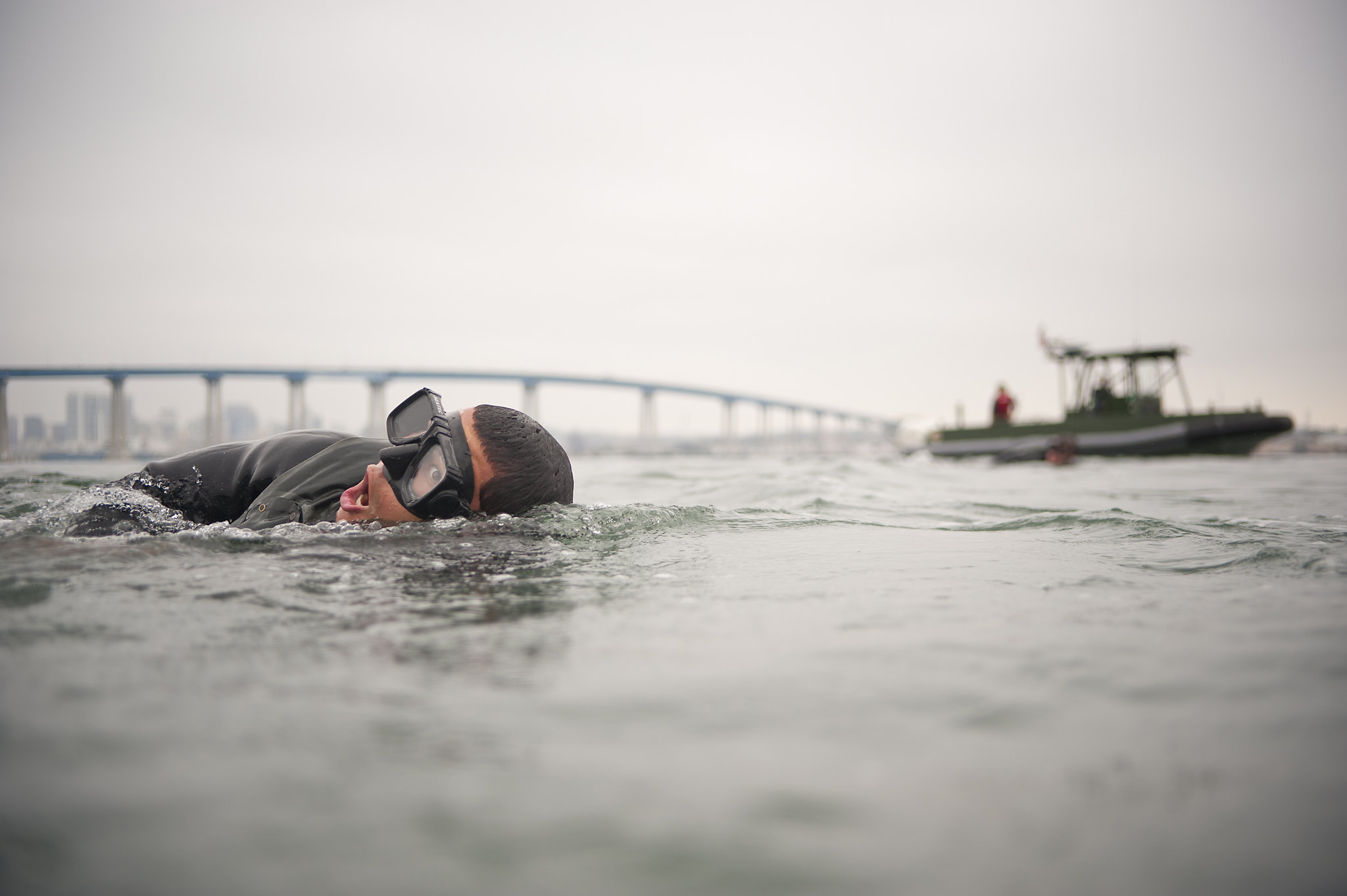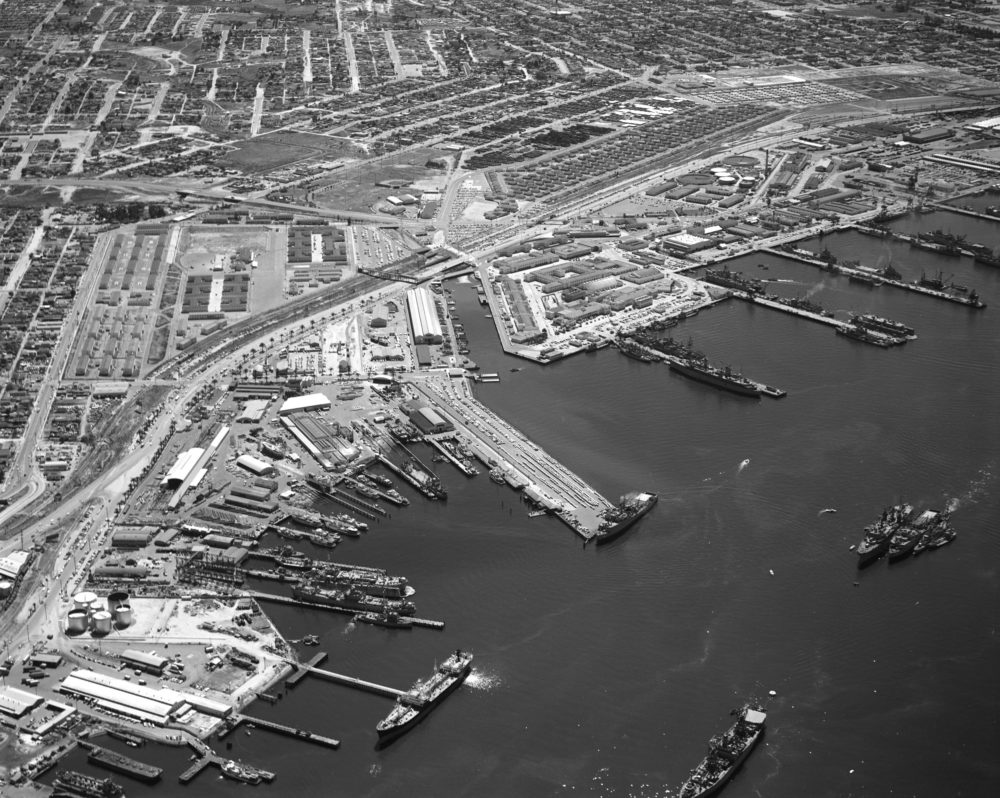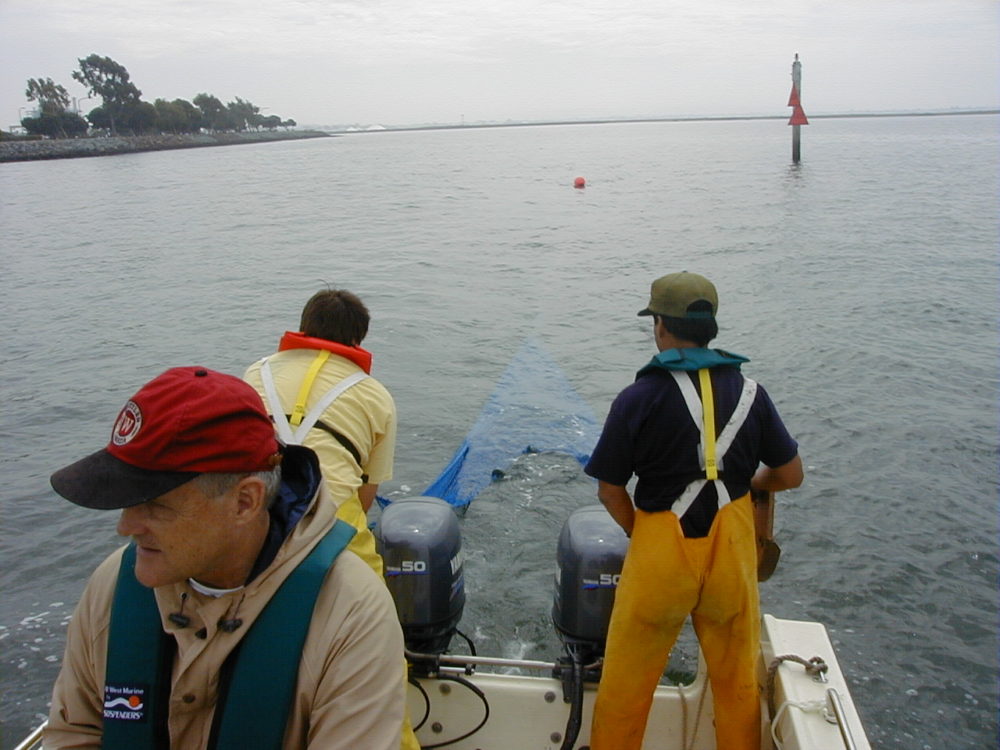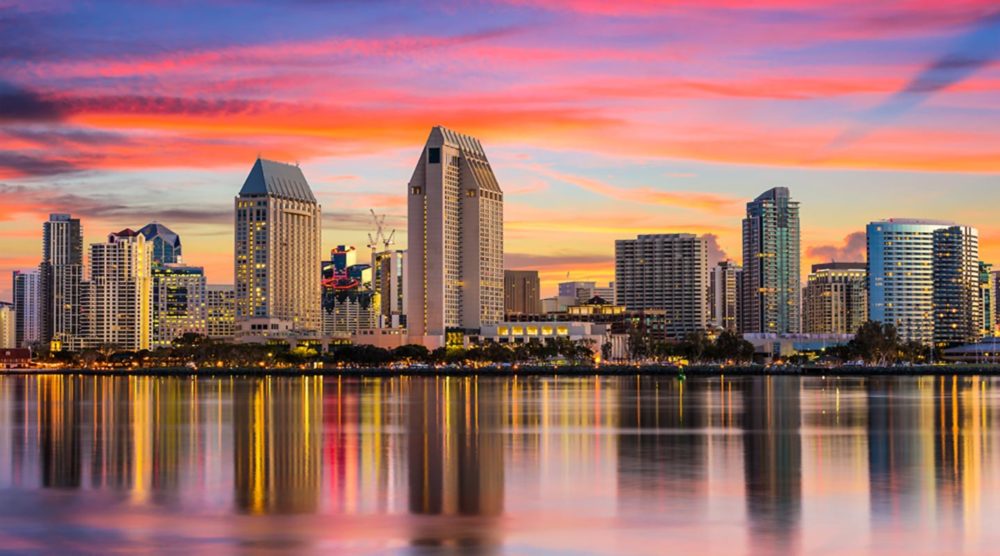
A Navy SEAL conducts a practice swim in the waters of the San Diego Bay. (US Navy photo)
![]() When an ad for San Diego tourism comes on, you’re guaranteed to see clips of people running on one of their world-famous beaches. Clips of people riding surfboards, paddling around in the Bay or a slow camera pan of sun-kissed water and a sandy beach. San Diego is a water wonderland, with “70 miles of glorious coastline, our signature attraction” as the tourism website proclaims.
When an ad for San Diego tourism comes on, you’re guaranteed to see clips of people running on one of their world-famous beaches. Clips of people riding surfboards, paddling around in the Bay or a slow camera pan of sun-kissed water and a sandy beach. San Diego is a water wonderland, with “70 miles of glorious coastline, our signature attraction” as the tourism website proclaims.
Looking out over San Diego’s sparkling Bay and waterfront, people may assume it has always been this way. Clean water just magically occurs in always sunny San Diego.
As wastewater professionals, we know it has not always been this way.
It has taken decades of hard work, thousands of construction and improvement projects and billions of dollars to build world class sewers and water resource recovery systems in San Diego. One pillar of the region’s success is the 1972 Clean Water Act and the permit requirements and Federal funding that came along with it.
“The data shows the Bay is cleaner now than it’s ever been. Only when you look back do you see the changes we’ve achieved over time,” said David Gibson, the Executive Officer of the San Diego Regional Water Quality Control Board. “The clean-up of San Diego Bay was the result of substantial investments made by the public through the agencies that represent them, such as cities, the county, port, US Navy and others.”
Once surrounded by marshes and estuaries, the San Diego Bay became the receiving water for millions of gallons of sewage and industrial waste as the region grew from a small, mission town in the 1800s into a booming industrial, military and ship building city by the 1930s. One regulator said the Bay had become “a metropolitan cesspool.”
With just one inlet and outlet, sewage sat putrefying, generating odors next to the bustling downtown and at the heart of the US Navy’s largest west coast port. They asked city leaders to do something about the sewage after hydrogen sulfide started corroding the hull of navy ships. The horrendous smell worried San Diego civic boosters their growing tourism business would start to decline.
Galvanized into action to save their bay, leaders from San Diego kicked off an effort in 1935 to build the city’s first wastewater plant, the Bayside Treatment Plant. Neighboring cities also started building small treatment plants to serve their regions.

Built in 1935 the Bayside Treatment Plant, shown in the upper right-hand corner of the photo, was San Diego’s first attempt to clean-up the Bay (San Diego History Center)
This led to a three-decade race to continually build and expand treatment plants to keep up with the ever growing flows of wastewater from San Diego’s ever expanding population.
From 1935 to 1960 the story remained the same – treatment plants were built, the bay would improve, facilities were soon overwhelmed, sewage would bypass and the bay would once again start to degrade.
Photos from the Historical Society’s archive show blobs of grease and solids still floating in the Bay in the 1950s. It had the consistency of “brown split pea soup,” one regulator noted, and the County Health Department banned any human contact with the Bay due to pollution. San Diego leaders realized a larger, regional solution was needed.
After water quality reports were compiled by the Regional Board and a design committee chaired by CWEA Past President A.M. Rawn came up with options, in 1952 leaders from San Diego, neighboring cities and the county agreed a joint effort was needed. San Diego’s regional Metro System was formed.
At the heart of the plan was a single, massive primary treatment plant located on Point Loma with a 2-mile ocean outfall pipeline. Started up in 1963, the regional system used large pumping plants to route sewage around the Bay and out to the Point Loma Wastewater Treatment Plant facing the ocean along steep cliffs on the desolate point.
“The results were very quick. You saw an improvement in San Diego Bay right away. That gave positive feedback for the Regional Water Board as a regulatory agency, as well as the public and agencies,” said Mr. Gibson. “When we do these things, it actually makes a difference. We should keep doing them.”
After a few years, even Point Loma was facing a familiar problem – it was nearing maximum capacity as San Diego kept growing.
In 1949, California’s Legislature passed the Dickey Act establishing the State Water Board and nine regional boards, including the San Diego Regional Water Quality Control Board, to help cities address growing water pollution across the State. This was followed in 1969 by the Porter-Cologne water quality act and three years later Congress passed the Clean Water Act with an overwhelming majority, overriding President Nixon’s initial veto of the Act.
The State and Federal rules brought regulators and discharge permits into the mix as well as funding. As San Diego leaders grappled with sewage issues they ran into opposition from residents – they vetoed treatment plant locations close to homes and rejected construction bonds. The city was always searching for funding for the massive projects they needed to build.
“The Clean Water Act and its funding mechanism helped move the City’s Clean Water Program along much sooner and made it easier for the region to build projects. It gave the impetus for San Diego to solve its own particular issues with wastewater, which for many years was disposal in the Bay and that just didn’t work,” said Tom Rosales, Assistant Director of the City of San Diego’s Water Recovery Branch.
The Clean Water Act provided the funding the City needed to continue expanding and improving their system. Federal funds were used to expand and upgrade Point Loma three times in 1975, 1983 and 1985, finally reaching its maximum capacity of 240 million gallons per day. Droughts and water conservation in the 1980s meant wastewater flows leveled off, removing the pressure to continually expand.
Photos by the City of San Diego
A primary objective of the Clean Water Act and the intent of Congress was to require all treatment plants in America to add secondary treatment systems to lower the biological oxygen demand (BOD) of treated effluent to a level that would keep receiving waters healthy.
Point Loma’s isolated location along steep cliffs meant adding secondary treatment might cost $1.8 billion in today’s dollars, according to engineering estimates.
Before committing to investing enormous resources, the City and Southern California Costal Water Research Program studied the kelp beds around the City’s ocean outfall. The studies found no detrimental impacts on the ecosystem from Point Loma’s effluent, although they did recommend extending the ocean outfall to 4-miles in length.

A scientific team from the Regional Water Quality Control Board, Region 9 sample San Diego Bay in the 1990s. (photo from Dave Gibson)
As Mr. Gibson noted, the Clean Water Act specifically calls on municipalities and regulators to maintain the chemical, physical, and biological integrity of the nation’s waters. Study after study confirmed Point Loma’s effluent was not degrading the ocean environment.
The EPA, State and City spent 1980-1995 in and out of court and consent decree negotiations trying to iron out the discharge permit for Point Loma as required by the Clean Water Act.
The EPA called for the addition of secondary treatment, while the City continually requested a 301(h) waiver from secondary treatment requirements. The City and other parties argued the cost to expand Point Loma was too great, $1.8 billion in today’s dollars, and the benefits too small. In each case, the judges agreed.
“I think the debates over the Point Loma permit are absolutely worth it. Starting in 1972 the city’s treatment systems improved with each permit cycle. They added more tanks for solids control, improved settling and the BOD levels each year to meet the permits,” said Mr. Gibson. “This is a net benefit for San Diegans, but it wouldn’t have happened without the ratcheting down of the permit program under the Clean Water Act.”
All that wrangling in court might seem exhausting for regulators and city staff; however, both groups said they’re proud of the rigorous scientific process. According to Mr. Rosales and Mr. Gibson, the level of public transparency required during the process is important and a spirit of partnership and cooperation has now developed between the EPA, State and public utilities staff even if the case ended up in court now and then.
“The City didn’t go into a closed room and come up with a plan by ourselves. There’s definitely engagement with our community, EPA, environmental stakeholders and the scientific community are all involved,” said Mr. Rosales.
Scientific monitoring and studies of the kelp beds and ocean outfall area began in the 1950s before the pipeline was installed and continue to this day, a requirement of Point Loma’s permit. The ocean is cleaner now than 50 years ago and a variety of whales are returning to the area including humpback and blue whales.
“We have shown through years of studies and reams of monitoring data Point Loma’s treated effluent is not causing any harm to the marine environment,” said Amy Dorman, the City’s Deputy Director of the Pure Water Program. “We’ve been able to use those public utility funds on other capital improvement projects such as sewer system improvements and water recycling.”
San Diego’s wastewater history includes a never-ending cycle of building treatment plants and the region’s population outgrowing them. This led San Diego planners as early as 1952 to sketch out plans for a regional water recycling system. The plan featured a new water reclamation plant and distribution systems reaching as far as Balboa Park and Mission Valley to reuse the water for irrigation and take pressure off the main sewer system. The plan didn’t move forward but planners kept trying.
In arid San Diego, dependent on imported water from the Colorado River and State Water Project, the idea of recycling wastewater for beneficial reuse took hold early within the public utilities department. The Porter-Cologne Act further encourages cities to consider water recycling as part of their water quality control plans.
San Diego leaders took the concept seriously and in 1967 funded from city coffers one of the first experimental reverse osmosis wastewater recycling plants inside Point Loma after the EPA declined their grant request, according to a history of the region’s sewerage system by Jon Jamieson.
Photos above provided by the City of San Diego
When the debate over Point Loma’s permit and secondary treatment came up in the 1980s, the EPA and Regional Board looked favorably at the city’s plan to build two satellite water reclamation plants as part of the larger Clean Water Program. It was a way to reduce loading and improve Point Loma’s performance as well as beneficially reuse the water.
“The Clean Water Act compelled the City to become serious about the Pure Water project,” said Mr. Gibson. “It solves two challenges. One is how to deal with that very large discharge of treated sewage offshore, and how to also provide for a resilient water supply as we face growing droughts and longer drought cycles. The Pure Water project does both for the city.”
Many wastewater professionals say the Clean Water Act gave them their career. For Ms. Dorman the Act led to San Diego’s Clean Water Program and dozens of construction projects she’s worked on and led.
“My work has been in response to Clean Water Act requirements,” said Ms. Dorman. “It has supported our industry and major advances such as the Pure Water project. Much of the engineering research and academic work addressing wastewater challenges were completed because the Clean Water Act brought them to the forefront.”
Following the EPA consent decree requirements, two water reclamation plants were completed in the 1990s, one in north county and another in the south. They distribute tertiary treated water for landscape irrigation and for San Diego’s growing industrial businesses.
Now under construction, phase 1 of the Pure Water program will use advanced treatment technologies to produce 30 million gallons per day of safe, clean drinking water for the city. The purified water will be added to a nearby reservoir. The EPA is providing a $733 million WIFIA loan to help finance construction.
The City aims to eventually achieve 50% of their drinking water supply from the Pure Water facility.
“I think the Clean Water Act spurred our whole water recycling program,” said Ms. Dorman. “The first step was building the non-drinking water reclamation plants. Now with Pure Water, we’re progressing into the ability to take it even further. That’s really going to help us maximize how much we’re able to recycle.”
How do you go from a Bay full of sewage in the 1950s to building one of the most advanced treatment systems in the world in 2021? One step at a time said Mr. Gibson from the Regional Board.
“It was the success stories that propelled the Water Board forward from 1972 to present, to do the right thing in the face of rather significant opposition,” said Mr. Gibson. “None of those permit decisions were popular. It was bad for business. It would impair military defense. It would cost the public too much money. It’s only after you work through the issues, identify where there are reasonable changes to be made and rely upon scientific evidence to guide permitting do we get those success stories. Then we look back and say, ‘Wow, it was really bad back then and it’s so much better now.’ It’s easy to take that for granted.”
Another secret to the region’s success is a commitment to research and planning. At each major turning point in the history of the sewage system, City leaders would initiate a study and consider multiple options. There are dozens of ideas, treatment plants and projects that were carefully considered but never built.
“A lot of thought and science went into our projects, such as examining the viability of the advanced primary treatment at Point Loma and its ability not to impact the marine environment.” Said Mr. Rosales. “With the Pure Water Program we’re taking more of that mass balance out of the discharge and it shows San Diego’s dedication to the environment and at the same time developing a local water resource. These projects demonstrate a lot of thought and good planning by San Diego officials over many, many years.”

San Diego Bay (Adobe stock)